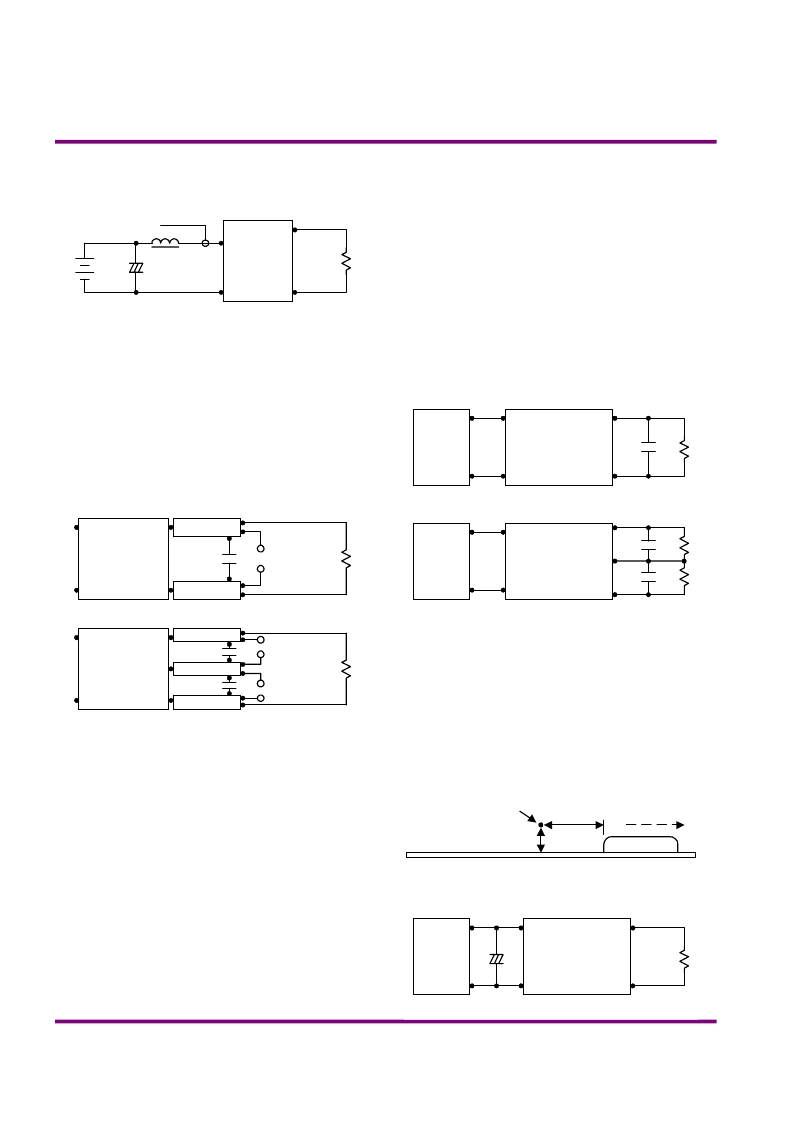- 您現(xiàn)在的位置:買賣IC網(wǎng) > PDF目錄376145 > MAU121 (Electronic Theatre Controls, Inc.) 15821183 PDF資料下載
參數(shù)資料
| 型號: | MAU121 |
| 廠商: | Electronic Theatre Controls, Inc. |
| 英文描述: | 15821183 |
| 中文描述: | 1瓦超小型SIP的直流/直流轉(zhuǎn)換器(單和雙輸出) |
| 文件頁數(shù): | 5/6頁 |
| 文件大小: | 69K |
| 代理商: | MAU121 |

Test Configurations
Input Reflected-Ripple Current Test Setup
Input reflected- ripple current is measured with a inductor
Lin (4.7uH) and Cin (220uF, ESR < 1.0[ at 100 KHz) to
simulate source impedance.
Capacitor Cin, offsets possible battery impedance.
Current ripple is measured at the input terminals of the
module, measurement bandwidth is 0- 500 KHz.
Peak-to-Peak Output Noise Measurement Test
Use a Cout 0.33uF ceramic capacitor.
Scope measurement should be made by using a BNC
socket, measurement bandwidth is 0- 20 MHz. Position the
load between 50 mm and 75 mm from the DC/DC Converter.
Design & Feature Considerations
Maximum Capacitive Load
The MAU100 series has limitation of maximum connected
capacitance at the output.
The power module may be operated in current limiting
mode during start- up, affecting the ramp- up and the startup
time.
For optimum performance we recommend 100
u
F
maximum capacitive loadfor dual outputs and 220
u
F
capacitive loadfor single outputs.
The maximum capacitance can be found in the data
.
Input Source Impedance
The power module should be connected to a low
ac- impedance input source. Highly inductive source
impedances can affect the stability of the power module.
In applications where power is supplied over long lines and
output loading is high, it may be necessary to use a capacitor
at the input to ensure startup.
Capacitor mounted close to the power module helps
ensure stability of the unit, it is commended to use a good
quality low Equivalent Series Resistance (ESR < 1.0[ at 100
KHz) capacitor of a 2.2uF for the 5V input devices, a 1.0uF for
the 12V,15V input devices and a 0.47uF for the 24V devices.
Output Ripple Reduction
A good quality low ESR capacitor placed as close as
practicable across the load will give the best ripple and noise
performance.
To reduce output ripple, it is recommended to use 1.0uF
capacitors at the output.
Thermal Considerations
Many conditions affect the thermal performance of the
power module, such as orientation, airflow over the module
and board spacing. To avoid exceeding the maximum
temperature rating of the components inside the power
module, the case temperature must be kept below 95°C.
The derating curves are determined from measurements
obtained in an experimental apparatus.
M A U 1 0 0 S eries
MINMAX
8
+Out
-Out
+Vin
-Vin
DC / DC
Converter
Load
Battery
+
Lin
+
Cin
To Oscilloscope
Current
Probe
+Out
-Out
+Vin
-Vin
Dual Output
DC / DC
Converter
Resistive
Load
Scope
Copper Strip
Cout
Com.
Scope
Cout
+Out
-Out
+Vin
-Vin
Single Output
DC / DC
Converter
Resistive
Load
Scope
Copper Strip
Cout
+
+Out
-Out
+Vin
-Vin
DC / DC
Converter
Load
DC Power
Source
+
-
Cin
+Out
-Out
+Vin
-Vin
Load
DC Power
Source
+
-
Cout
Com.
Dual Output
DC / DC
Converter
+Out
-Out
+Vin
-Vin
Load
DC Power
Source
+
-
Cout
Single Output
DC / DC
Converter
DUT
Position of air velocity
probe and thermocouple
50mm / 2in
Air Flow
15mm / 0.6in
相關(guān)PDF資料 |
PDF描述 |
|---|---|
| MAU122 | 1 Watt Ultra Miniature SIP DC/DC Converters (Single and Dual Outputs) |
| MAU123 | 1 Watt Ultra Miniature SIP DC/DC Converters (Single and Dual Outputs) |
| MAU124 | 1 Watt Ultra Miniature SIP DC/DC Converters (Single and Dual Outputs) |
| MAU125 | 1 Watt Ultra Miniature SIP DC/DC Converters (Single and Dual Outputs) |
| MAU126 | 1 Watt Ultra Miniature SIP DC/DC Converters (Single and Dual Outputs) |
相關(guān)代理商/技術(shù)參數(shù) |
參數(shù)描述 |
|---|---|
| MAU122 | 制造商:Minmax Technology Co Ltd 功能描述:1 Watt Miniature SIP DC/DC Converter, Bulk |
| MAU123 | 制造商:MINMAX POWER, INC. 功能描述:1 Watt Miniature SIP DC/DC Converter, Bulk |
| MAU124 | 制造商:未知廠家 制造商全稱:未知廠家 功能描述:1 Watt Ultra Miniature SIP DC/DC Converters (Single and Dual Outputs) |
| MAU125 | 制造商:未知廠家 制造商全稱:未知廠家 功能描述:1 Watt Ultra Miniature SIP DC/DC Converters (Single and Dual Outputs) |
| MAU126 | 制造商:未知廠家 制造商全稱:未知廠家 功能描述:1 Watt Ultra Miniature SIP DC/DC Converters (Single and Dual Outputs) |
發(fā)布緊急采購,3分鐘左右您將得到回復(fù)。